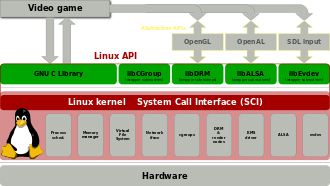Hybris (software)
| Original author(s) | Carsten Munk |
|---|---|
| Developer(s) | Mer, Jolla, Open webOS community, Canonical Ltd. |
| Initial release | 5 August 2012[1] |
| Repository |
github |
| Development status | Active |
| Written in | C, C++ |
| Operating system | Linux |
| Type | Compatibility layer |
| License | Apache License 2[2] |
| Website |
github |



Hybris or libhybris is a compatibility layer for computers running Linux distributions based on the GNU C library, intended for using software written for Bionic-based Linux systems, which mainly includes Android libraries and device drivers.[3]
History
Hybris was initially written by Carsten Munk, a Mer developer, who released it on GitHub on 5 August 2012[1] and publicly announced the project later that month.[3][4] Munk has since been hired by Jolla as their Chief Research Engineer.[5]
Hybris has also been picked up by the Open webOS community for WebOS Ports,[6][7] by Canonical for Ubuntu Touch[5][8] and by the AsteroidOS[9] project.
In April 2013, Munk announced that Hybris has been extended to allow Wayland compositors to use graphic device drivers written for Android.[5][10][11] Weston has had support for libhybris since version 1.3, which was released on 11 October 2013.[12]
Features
Hybris loads "Android libraries, and overrides some symbols from bionic with glibc"[3] calls, making it possible to use Bionic-based software, such as binary-only Android drivers, on glibc-based Linux distributions.
Hybris can also translate Android’s EGL calls into Wayland EGL calls, allowing Android graphic drivers to be used on Wayland-based systems. This feature was initially developed by Collabora's Pekka Paalanen for his Android port of Wayland.[5][13][14][15]
See also
References
- 1 2 "Initial commit of stskeeps/libhybris". GitHub. 2012-08-05. Retrieved 2013-07-03.
- ↑ "libhybris/hybris/COPYING". GitHub. 2013-04-04. Retrieved 2013-07-03.
- 1 2 3 Carsten Munk. "So, introducing libhybris,…". Google+. Retrieved 2013-07-03.
- ↑ "Libhybris: Load Android Libraries, Override Bionic Symbols". Phoronix. 2012-09-25. Retrieved 2013-07-03.
- 1 2 3 4 Carsten Munk (2013-04-11). "Wayland utilizing Android GPU drivers on glibc based systems, Part 1". Mer Project. Retrieved 2013-07-03.
- ↑ "Open webOS ported to Nexus 7 over holiday break". The H Open. 2013-01-07. Retrieved 2013-07-03.
- ↑ "WebOS-Ports". WebOS-Ports. Retrieved 2013-07-03.
- ↑ "libhybris in Launchpad". Launchpad.net. 2013-02-05. Retrieved 2013-07-03.
- ↑ "AsteroidOS: An open-source operating system for smartwatches". AsteroidOS. Retrieved 27 January 2016.
- ↑ Munk, Carsten (2013-05-08). "Wayland utilizing Android GPU drivers on glibc based systems, Part 2". Mer Project. Retrieved 2013-07-03.
- ↑ "Jolla Brings Wayland Atop Android GPU Drivers". Phoronix. 2013-04-11. Retrieved 2013-07-03.
- ↑ "Wayland and Weston 1.3 release notes". 2013-10-11.
- ↑ Munk, Carsten (2013-04-13). "libhybris/hybris/egl/platforms/common/wayland-android.xml". GitHub. Retrieved 2013-07-03.
- ↑ "First Signs Of Wayland Running On Android". Phoronix. 2012-04-27. Retrieved 2013-07-03.
- ↑ Pekka Paalanen (2012-09-24). "Wayland on Android: upgrade to 4.0.4 and new build integration". Retrieved 2013-07-03.